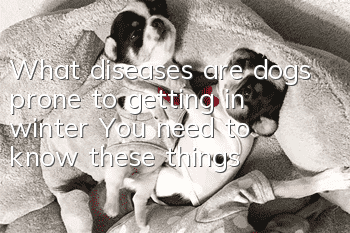What diseases are dogs prone to getting in winter? You need to know these things!

Canine infectious hepatitis
Let’s talk about canine infectious hepatitis first. Please don't be nervous. This disease is not contagious to humans. Canine infectious hepatitis is an acute septicemic infectious disease caused by canine adenovirus type I. Clinically, it is mainly characterized by jaundice, anemia, corneal opacity (blue eye disease), and elevated body temperature. Infectious hepatitis occurs regardless of gender and age. Although it can occur in dogs of all ages, puppies are more likely to be affected, their condition is serious, and their mortality rate is high.
Unlike canine distemper, this disease is not usually spread through respiratory infection, but mainly through infection of the digestive tract. The incubation period is about 7 days. The most acute cases die within hours after vomiting, abdominal pain and diarrhea. Acute depression, chills, body temperature rising to about 40.5 degrees Celsius, loss of appetite, tendency to drink water, vomiting, diarrhea and other symptoms. In late acute symptoms, anemia, jaundice, pharyngitis, tonsillitis, and lymphadenopathy appear; characteristic symptoms are also In the eyes, the cornea is cloudy and turns blue, while the cornea and conjunctiva are edematous, the eyes are half closed, and there is a lot of blood flow. Serosal secretion; corneal opacification is characterized by spreading from the center to the periphery, which can lead to corneal perforation in severe cases. Most dogs whose corneal opacification gradually disappears recover.
Adenovirus type II infection
Let’s introduce canine adenovirus type II infection. Canine adenovirus type Ⅱ infection can cause infectious laryngotracheitis and pneumonia in dogs. This disease can cause the disease in litters of puppies under 4 months old. The incubation period of canine adenovirus type II infection is 5 to 6 days, with persistent fever and body temperature around 39.5°C. Serous rhinorrhea from the nose can cause watery nasal fluid to be sprayed out with breathing. Paroxysmal dry cough appeared 6 to 7 days later, followed by wet cough, shortness of breath, gong sound on tracheal auscultation, and oral examination showed enlarged tonsils and red and swollen pharynx. As the disease progresses, it can lead to necrotizing pneumonia. Sick dogs show depression, not eating, and vomiting. The disease is often easily mixed with canine distemper and other respiratory diseases. Dogs with mixed infection often cause great difficulties in treatment and have a high mortality rate.
Coronavirus
Finally, let’s introduce coronavirus. Canine coronavirus can cause varying degrees of gastroenteritis symptoms in dogs. It is characterized by symptoms such as frequent vomiting, diarrhea, anorexia, depression, and dehydration. This disease occurs throughout the year, but is more common in winter. Sick dogs are the main source of infection, and dogs can be infected through the respiratory tract and digestive tract. Once the disease occurs, it is difficult for dogs in the same litter or room to avoid infection. The disease spreads quickly and can spread to the entire population in a few days. The incubation period is 1 to 3 days. Clinical symptoms vary in severity. Some dogs have no obvious symptoms, and some dogs may show symptoms of fatal gastroenteritis.
Symptoms of this disease are sleepiness, weakness and anorexia. Initially, vomiting lasts for a few days, followed by diarrhea and loose or watery stools. Sometimes the stool is mixed with mucus and a small amount of blood. The sick dog has a high degree of dehydration, sunken eyeballs, elastic skin, rapid weight loss, and weight loss. Most dogs' body temperature does not change much and their white blood cells are normal or low. Children with this diseaseDogs have a certain mortality rate, and some puppies die quickly. Symptoms in adult dogs are generally more severe than those in puppies, and most dogs recover after 7 to 10 days of symptomatic treatment. Preventing these diseases is not difficult. It doesn’t matter if you give your dog six vaccines on time.
- How to tell if your dog is fat? Is your dog overweight?
- Will your dog catch a cold if you blow the air conditioner? What should you do if your dog catches a cold if you blow the air conditioner?
- The dog's mouth bites and shakes. Why does the dog's mouth occasionally shake and bite?
- How to cut a dog's hair? Do you know how to cut a dog's hair correctly?
- Can dogs eat raw eggs? Why can’t dogs eat egg whites?
- Common Dog Problems in Summer How to Deal with Different Dog Problems
- How to keep dogs away from skin diseases. If you do this, will you see if your dog will still be infected with skin diseases?
- What causes anorexia in dogs? Dogs will become anorexic due to lack of exercise. Hounds run at least 5KM every day.
- Can dogs eat liver? What should you pay attention to when giving liver to your dog?
- Can canine herpes virus be transmitted to humans? Owners should not be too nervous



